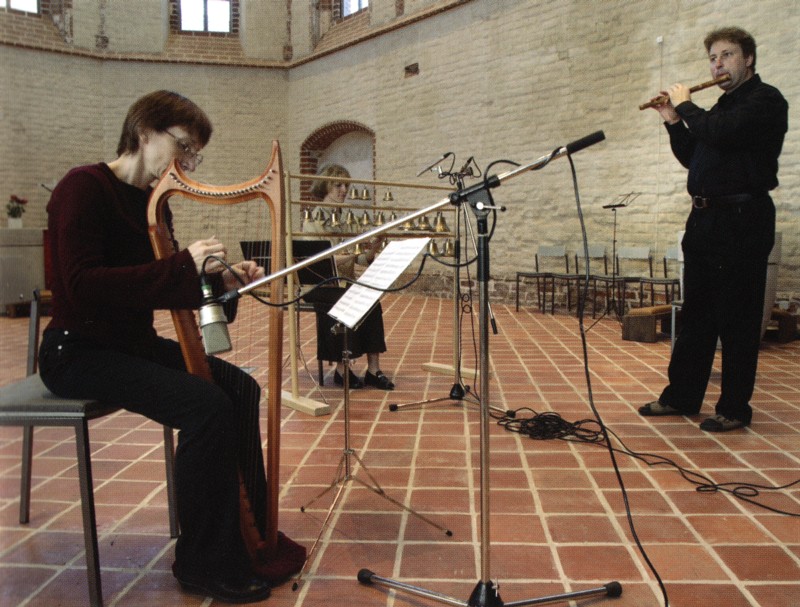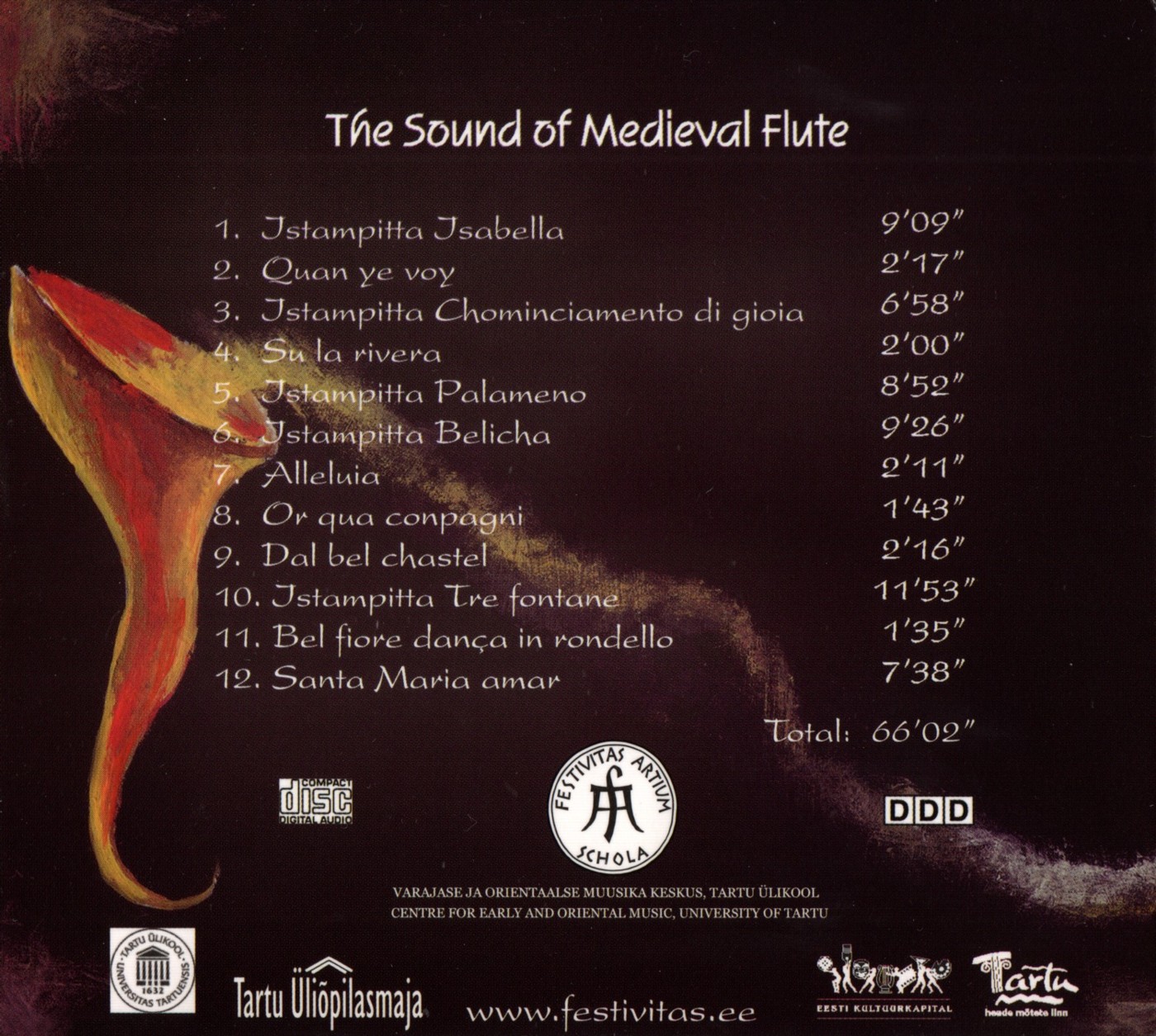The Sound of Medieval Flute
/ Festivitas Artium Schola

discogs.com
festivitas.ee
University of Tartu
2006
[66:02]
1. Istampitta Isabella [9:09]
London, BL. Add. 29987 (1400)
2. Quan ye voy [2:17]
Florence, BNC, Panciatichiano 26 (XIV—XV cent.)
3. Istampitta Chominciamento di gioia [6:58]
London, BL. Add. 29987 (I400)
4. Su la rivera [2:00]
Codex Rossi (1340)
5. Istampitta Palameno [8:52]
London, BL. Add. 29987 (1400)
6. Istampitta Belicha [9:26]
London, BL. Add. 29987 (1400)
7. Alleluia [2:11]
Johannes Tinctoris (c. 1435-1511)
8. Or qua conpagni [1:43]
Codex Rossi (1340)
9. Dal bel chastel [2:16]
Codex Rossi (1340)
10. Istampitta Tre fontane [11:53]
London, BL. Add. 19987 (1400)
11. Bel fiore dança in rondello [1:35]
Anon. (XIV cent.)
12. Santa Maria amar [7:38]
Cantigas de Santa Maria (XIII cent.)
CSM 7
Tracks 11 and 12 arranged by Lilian Langsepp

Raho Langsepp — medieval flutes
Lilian Langsepp — gothic harp
Helena Uleksin — bells, medieval flute
Recorded in the University of Tartu Council Hall
(august 2006, tracks 1, 2, 3, 4, 6, 8, 9, 10, 12)
and Tartu St John's Church (august 2005, tracks 5, 7, 11)
Recorded by Peeter Konks
Digital editing and mastering by Peeter Konks
VARAJASE JA ORIENTAALSE MUUSIKA KESKUS, TARTU ÜLIKOOL
CENTRE FOR EARLY AND ORIENTAL MUSIC, UNIVERSITY OF TARTU
Booklet texts: Raho Langsepp, Lilian Langsepp
Editor: Helena Uleksin
Enghsh translation: Meelis Leesik
German translation: Axel Jagau
Cover and booklet design: Hehi Marie Langsepp
Cover and booklet layout: Helena Uleksin
Booklet photos: Malev Toom
The Sound of Medieval Flute
The selection of the title "The Sound of Medieval Flute" is not
fortuitous and aims to intrigue those listeners who know that no
medieval transverse flute finds have been reported so far. What kind of
transverse flutes were played in medieval Europe and what they sounded
like can only be intuited by piecing together a kaleidoscope of
information preserved in the graphic arts, in literary and poetic works
touching on the performance practice of medieval instrumental music in
folk music traditions using similar instruments and—there is no
hiding that anyway!—adding a certain measure of personal
imagination to the mix. No doubt the medieval transverse flute was
similar in its construction to the oldest flutes, reports of which have
been recorded in Asia, a part of the world where the instrument enjoys
continued popular use to these days. The flutes in question are more or
less cylindrical in shape, with six or seven finger holes in addition
to the blowing hole. A central question still open to debate concerns
the playing technique used by medieval flutists. If medieval flutes had
small finger holes, their playing technique could be largely
assimilated to those of the Renaissance and Baroque flutes and the
recorder, in which cross-fingering is used for obtaining various
alterations. If, however, the finger holes of medieval flutes were big,
as is the case with the Indian flutes still in use today,
cross-fingering would no longer be effective and flutists would have
had to resort to half-hole technique in which semitones are obtained by
partially opening a hole (by lifting the finger or rolling it upwards).
Whether such technique was indeed used in the medieval period has not
been conclusively proved or disproved. If we are to consider the fact
that medieval itinerant musicians often played out of doors, which
required a wider reach of sound of the instruments used, it seems
probable that the internal diameter of their flutes and consequently
the finger holes were bigger. This presumption is supported by
depictions of medieval flutes preserved in the graphic arts, which have
been analysed in detail in the work of Liane Ehlich.
It has also been suggested that the medieval transverse flutes are
likely to have been used for playing simple diatonic melodies which
would not have called for the use of half-hole techniques even if the
flutes in question had bigger finger holes. The musicians of the time,
however, were professionals for whom playing their instrument was a
means of winning their daily bread and who continued to hone their
skills throughout their lives. In view of that it would not make sense
to suppose that they limited themselves to playing solely diatonic
music, avoiding chromatisms and more complicated pieces which are a
usual occurrence in the manuscripts of the period. Based on images
preserved in the graphic arts works depicting flutists side by side
with fiddle players, this author firmly believes that flutes were used
to play pieces of a complexity equal to those played on the fiddle,
which is suggested to have been the principal instrument used to play
estampies. Whether this was achieved entirely by means of half-hole
techniques or in a combination with cross-fingering is a matter for
conjecture. The aim of this recording is to show that the flutes with
bigger finger holes can very well have been employed for playing fully
chromatic pieces by using only the half-hole technique. Undoubtedly
this choice of technique results in the creation of ornaments different
from those characteristic of cross-fingering and enables the musician
to alter the pitch of notes flexibly and smoothly, thus opening new
possibilities for interpreting medieval instrumental music.
As regards the material used to make flutes, graphic arts fragments
clearly point to bamboo, yet it is highly probable that flutes were
made chiefly of wood and bone. This is likely to have been so because
of the problems encountered by bamboo instruments in drier regions and
certainly also because of the fact that bamboo is not native to most of
the European territory. Magnificent-sounding transverse flutes,
however, can also be made of clay. Due to their deep and mellow sound,
we have preferred bamboo instruments for recording this CD. Three
bamboo flutes have been used: those in g (South Indian bamboo, tuned by
V. Hemapala Perera) and in G and c (respectively North and South Indian
bamboo, tuned by Raho Langsepp). In order to preserve the unique sound
of each instrument, inside oiling has been foregone.
The Consort's choice of the instruments including in addition to the
flutes also a harp and a bell chime serves to highlight the nuanced and
refined sound of the musical material performed. We support the view
according to which, unlike in Renaissance music, the emphasis of the
medieval period was not placed on varying the sound of the pieces
played by using a multiplicity of instruments representing different
musical timbres but rather aimed to achieve a maximum of nuance and
expression on one single instrument.
The bell chime (A—f') consists of bells made by the Swedish
family firm "Morells Metallgjuteri AB", established in 1920. In
founding and hand working their bells the firm employs traditional
methods descended from their forefathers.
The world of medieval harps was amazingly rich in varying sizes, shapes
and numbers of strings. The harp used to record this album is a copy
(made in 2000 by the German master harp maker Eric Wilhelm Kleinmann)
of the instrument that was purchased in mid-XIX century for the
Wartburg Art Collection and in all likelihood used to belong to the
famous Minnesinger Oswald von Wolkenstein (1377-1445). The slim,
Gothic-looking harp has 26 strings (G—d'''), which are tuned
diatonically. To play semitones, the resonant length of the strings has
to be reduced. In the estampie "Palamento" this is achieved by two
different techniques: the harpist uses the fingers of the left hand to
press the string against the harmonic curve of the harp (which raises
the pitch by a semitone) or against the bray pin on the sound box of
the harp (which raises the pitch by a full tone).
In addition to wide musical range owing to the number of strings fitted
on the instrument the Wartburg harp is characterised by a rich timbre
and lends itself easily to dynamic playing techniques. For instance, in
the estampie "Tre Fontane" this is demonstrated by backing the
high-resister glissandos played by the right hand with low-register
accompaniment played by the left. It is also noteworthy that the entire
instrument is equipped with L-shaped bray pins permitting the player to
create a vibrant buzzing sound characteristic of medieval harps. By
varying the position of the pins, the harp can be used to play quietly
yet in a highly nuanced dynamic manner. In rendering the estampies
recorded for this CD a combined approach has been used, with lower
strings tuned to resonate with a buzz and the higher in a regular
manner.
This CD is based chiefly on two Italian manuscripts: the London, BL.
Add. 2.9987 and Codex Rossi. Dating from 1400, London, BL. Add.
29987 is one of the central sources of medieval monodic instrumental
music available today. Through this manuscript a number of long and
extremely interesting estampies have been preserved for us, shedding
some light on the structure, sonic texturing and ornamentation of the 1
4th century instrumental music. We know today that Arabic music exerted
a considerable
influence on the development of European music. Indeed, an Oriental
flavour can surely be felt in the estampies in question, yet they
remain unmistakably European. Estampies have typically four to five
verses, which are repeated twice: with an 'open' and a 'closed' ending.
The next verse often incorporates a substantial portion of the previous
one, so the verses gradually grow in length. The first verse usually
introduces the main mood of the piece, the second verse takes the piece
into a high register and the third into a low register. As a rule, the
final verses have varying time signatures, often also changing the mode
(of the piece). All estampies in this manuscript are replete with
chromatisms and run rather long. In recording this CD, we have worked
with a facsimile edition of the manuscript. Occasional variations in
note length and pitch result from personal preference and improvisation.
Codex Rossi (compiled in Venice c. 1340) is one of the earliest sources
for the Italian Ars Nova style. The pieces it contains are vocal as in numerous other 14th and 15th
century manuscripts. Still, some researchers claim that the music in
these manuscripts may also have been performed instrumentally. In terms
of musical genres, Codex Rossi contains madrigals, caccias and ballatas.
The Centre of Early and Oriental Music Festivitas Artium Schola,
founded as a collaboration between the University of Tartu and the
concert agency Festivitas Artium in January 2000, is a natural
development in early music research and study in the University of
Tartu. It also continues the work of the ensemble Via Sonora and
contributes to carrying on the tradition of the Tartu Early Music
Festival. The aim and mission of FA Schola is to use music and music
research to compare and present the traditional cultures
of medieval Europe and the Orient. The Centre has brought together a
medieval consort the members of which also teach a variety of
instruments. As to the Centre's name, the original meaning of 'schola',
a Greek loan word in Latin, was 'spending time together intelligently',
a sense that was later conflated with the familiar and more modern
meanings of 'teaching' and 'erudition'. FA Schola appreciates both the
ancient and the modern meanings—besides regular studies and
teaching activities, the Centre organises many concert projects,
enlisting professional musicians and occasionally students from Estonia
as well as abroad.



